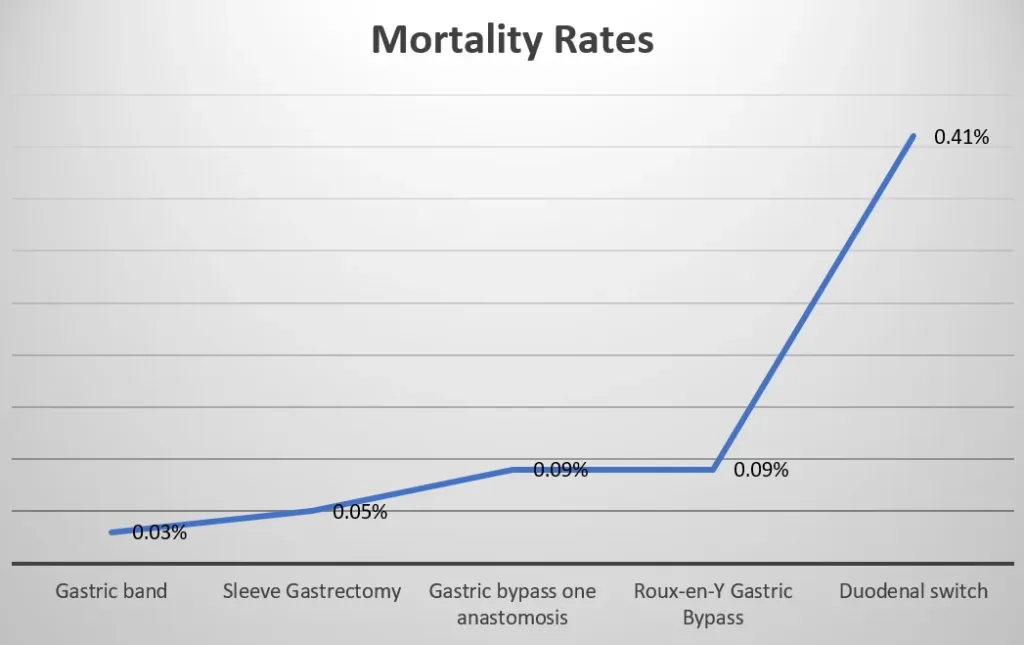Which is the safest weight loss surgery and associated with the least intra-operative, short-term, and long-term complications? Because surgery is a huge undertaking and one would definitely want to go for the least invasive form of weight loss intervention.
Among weight loss procedures, some are very safe especially if performed by a skilled and experienced surgeon.
Gastric Sleeve Surgery and Gastric Bypass are the most commonly performed procedures and are considered relatively safe compared to duodenal switch and biliopancreatic diversion.
| Buy: | Read: |
Obesity, Weight Loss Pills, and Surgeries …
Morbid obesity is a metabolic disorder. More and more people, especially teenagers are becoming obese. Because obesity is associated with many complications, treating it is important,
Among the various obesity-associated complications, diabetes, hypertension, sleep apnea, osteoarthritis, fatty liver, and dyslipidemia are very common.
Pharma companies are trying hard to produce the “magic pill” and have somewhat succeeded too as the latest drugs (Retatrutide and CagriSema) are associated with up to 30% weight loss
Currently used medical treatments for weight loss include Wegovy, Ozempic, Mounjaro, Saxenda, Contrave, Qsymia, and Xenical.
Weight loss surgeries have also evolved and the latest laparoscopic guided procedures (mini gastric bypass and laparoscopic gastric sleeve surgery) are very safe and effective, however, because of their invasive nature, people opt for these procedures only after they fail the medical therapies.
| Buy: | Read: |
The Safest Weight Loss Surgery with Fewer Deaths:
Mortality or death rate associated with weight loss surgery is probably the number 1 factor to know before opting for surgical intervention.
The higher the mortality rate (weight loss surgery-associated deaths), the less safe is the procedure.
On the other hand, the safest weight loss surgery is the one that is associated with the least number of deaths and long-term disability or morbidity.
The overall death rate, 30-day death rate, 90-day death rate, and peri-operative death rates have been studied with the different currently practiced weight loss surgeries.
A meta-analysis studied the death rates associated with the different weight loss surgeries. The proportion of patients dying from each procedure is listed here in ascending order i.e from the least to the highest number of deaths associated with the procedure [Ref]:
Types of Weight Loss Surgery | Mortality Rates |
| Gastric band | 0.03% (3 deaths in 10,000 procedures) |
| Sleeve Gastrectomy | 0.05% (5 deaths in 10,000 procedures) |
| Gastric bypass one anastomosis | 0.09% (9 deaths in 10,000 surgeries) |
| Roux-en-Y Gastric Bypass | 0.09% (9 deaths in 10,000 gastric bypass surgeries) |
| Duodenal switch | 0.41% (41 deaths in 10,000 procedures) |
As seen in the table above, the risk of a person dying from weight loss surgery is very small. The gastric band is the safest followed by Gastric Sleeve, Gastric Bypass, and Duodenal switch.
The risk of death from a Duodenal switch is 14 times greater than Gastric banding, 8 times greater than Sleeve Gastrectomy, and 5 times greater than Gastric bypass surgery.

| Buy: | Read: |
Which is the Least Invasive and the Safest Weight Loss Surgery?
The least invasive surgery is, the chances of developing complications are fewer. Invasive surgery is the one that involves the most incisions, dissections, resections, and anastomosis.
Surgical options are categorized here from the least invasive to the most invasive weight loss surgery.
Least invasive to most invasive weight loss surgery:
Type of Bariatric Surgery | How Invasive |
| Intragastric Balloon | Least Invasive |
| Laparoscopic Adjustable Gastric banding | Less Invasive |
| Laparoscopic Sleeve Gastrectomy | Invasive |
| Laparoscopic Roux-en-Y Gastric Bypass | Very Invasive |
| Laparoscopic Duodenal switch | Very very Invasive |
| Laparoscopic Biliopancreatic Bypass | The Most Invasive |
The safest weight loss surgery is based on the degree of manipulation of the gut and the natural anatomy.
The intragastric balloon is the safest procedure, followed by Gastric banding, Sleeve gastrectomy, Roux-en-Y Gastric Bypass, Duodenal switch, and Biliopancreatic Bypass.
Intragastric balloon system:
This is minimally invasive because it does not involve any kind of resection and is done through an endoscope.
It is a procedure and not a weight loss surgery. Intragastric balloons are currently of three major types. Two require the placement of balloons via an endoscope while one type is swallowed by the patient.
So, intragastric balloons are the safest of all the weight loss interventions, and the least invasive, but has their stomach-related side effects.
Laparoscopic adjustable gastric banding:
Laparoscopic adjustable gastric banding requires minimal dissection and one securing of the band with the stomach wall.
It is probably the second least invasive surgery and hence the safest weight loss surgery. It does not require any surgical dissections or resection of any part of the stomach.
Laparoscopic sleeve gastrectomy:
It involves the resection of the stomach only. Not much dissection is required in the rest of the gut. It does not cause significant malabsorption but has gastrointestinal side effects.
Among the most effective weight loss surgeries, Gastric Sleeve is one of the safest and most effective weight loss surgeries.
Laparoscopic roux en y gastric bypass:
This is a more extensive procedure because it involves the resection of the stomach wall. Along with it requires resection and anastomosis of the small gut. This puts the patient at risk of developing anastomotic leaks and other complications.
Gastric bypass is a very effective weight loss surgery. Its safety is almost comparable to gastric sleeve surgery. Newer methods are currently being practiced. One of the widely practiced methods is the “mini gastric bypass“. It is considered effective but safer than conventional gastric bypass surgery.
Laparoscopic duodenal switch:
This is an extensive procedure because it requires resection and anastomosis at multiple levels. Thus there is a risk of complications arising from the anastomosis as well as the risk of obstruction because adhesive band formation increases at a later stage.
Laparoscopic bilo pancreatic bypass procedure:
This is the most invasive and extensive procedure of all bariatric surgeries currently in practice. Like a duodenal switch, it requires multiple anastomoses but its complication rates are high.
Even some patients had to undergo a reversal of this procedure. which itself is a very high-risk procedure.
| Buy: | Read: |
The various complications associated with each of the above procedures are discussed in the next article: Complications of bariatric surgery.




